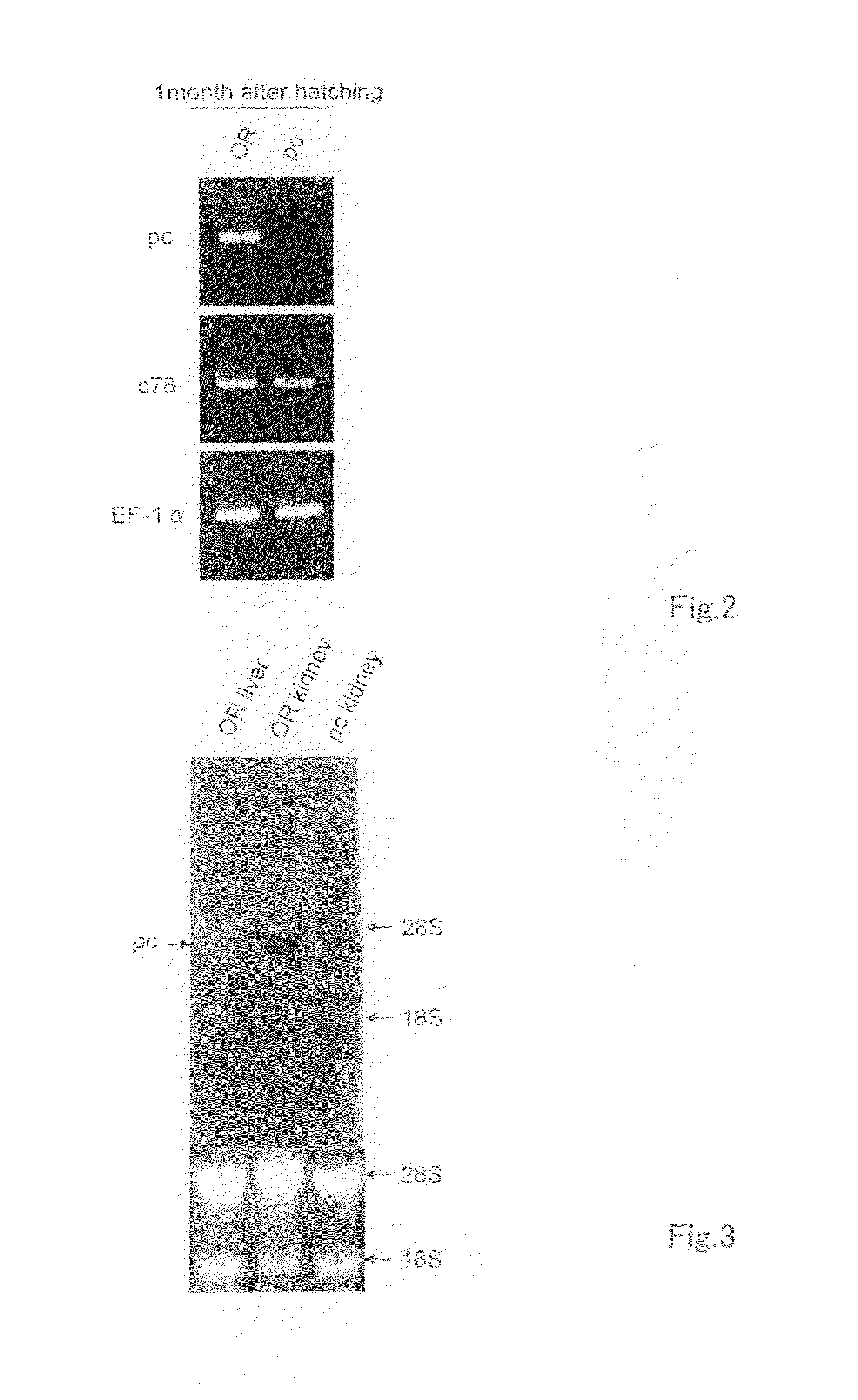Polycystic kidney disease-related gene and use thereof
- Summary
- Abstract
- Description
- Claims
- Application Information
AI Technical Summary
Benefits of technology
Problems solved by technology
Method used
Image
Examples
example 1
[0114]The present invention is described in detail below through examples, but the present invention is by no means limited thereto.
(Medaka Phylogenetic Analysis)
[0115]A phylogenetic analysis (846 individuals) was carried out using sibling mating between the progeny of the medaka pc mutant (hereinafter, also referred to as pc), which is the medaka strain wherein PKD occurs, and progeny of the HNI(+ / +) inbred strain. The BAC gene library used for screening originated in the Hd-rR (+1+) inbred strain. This BAC gene library was obtained from professor Hiroshi Hori, Graduate School of Science, Nagoya University.
[0116]After the BAC DNA was purified by a conventional mini-prep protocol, the BAC terminal was directly sequenced and mapped. After BAC174E15 was sheared using a HydroShear, the small DNA fragments were fractionated and removed using a Sep 400 Spun Column / Sepharose CL-4B (Amersham), and subcloned with PUC18 plasmids. A BAC174E15 shotgun library was prepared by ...
example 2
[0138](Medaka Kidney in situ Hybridization using a pc RNA Probe)
(1) Expression of pc mRNA in Wild Type Medaka
[0139]After the gut and other visceral organs were removed by necropsy, whole-mount in situ hybridization of the kidneys was carried out by conventional methods. As shown in the top row of FIG. 14, a DIG-labeled RNA probe (riboprobe) was synthesized by SP6 RNA polymerase in the presence of DIG-11-UTP using a plasmid vector containing the whole open reading frame of the pc cDNA as a template. For observation of the tissues wherein it was expressed, the collected kidneys were embedded in Technovit 8100™ and cut into 10μ sections with a microtome. The cell nuclei were stained with neutral red for visual identification of the sites where pc mRNA was not expressed. The top row of FIG. 15 shows images taken from the ventral side of pre-necropsy medaka at 0, 5, 20 and 30 days after hatching, and the bottom row shows images taken of sections prepared from a medaka at 5 days after hat...
example 3
[0141](Knockdown using Antisense Oligonucleotide)
(1) Preparation of Knockdown Medaka
[0142]GripNA from Active Motif, Inc. was used for the antisense oligonucleotides. The oligonucleotides were designed to form complementary strands to the 18 bases covering the start codons of the pc gene. By such a design the oligonucleotides could be expected to specifically inhibit the translation of pc mRNA. Because it is believed that 2 types of mRNA are produced from the pc gene due to a difference in splicing, and each is translated from a different start codon, the following antisense oligonucleotides were prepared: pcaNA=5′-CACTCATGTCTAAAACGG-3′ (SEQ ID NO: 55) and pcbNA=5′-ACTAAACATGGACTGTGT-3′ (SEQ ID NO: 56). Embryos inserted with approximately 0.5 ng of each by microinjection at cell stages 1 to 4 were raised to 0 to 5 days after hatching. Then paraffin sections were prepared, and the kidneys were examined.
(2) Knockdown Statistics
[0143]FIG. 17 shows the statistics related to the knockdown...
PUM
| Property | Measurement | Unit |
|---|---|---|
| Antisense | aaaaa | aaaaa |
Abstract
Description
Claims
Application Information
 Login to View More
Login to View More - Generate Ideas
- Intellectual Property
- Life Sciences
- Materials
- Tech Scout
- Unparalleled Data Quality
- Higher Quality Content
- 60% Fewer Hallucinations
Browse by: Latest US Patents, China's latest patents, Technical Efficacy Thesaurus, Application Domain, Technology Topic, Popular Technical Reports.
© 2025 PatSnap. All rights reserved.Legal|Privacy policy|Modern Slavery Act Transparency Statement|Sitemap|About US| Contact US: help@patsnap.com



